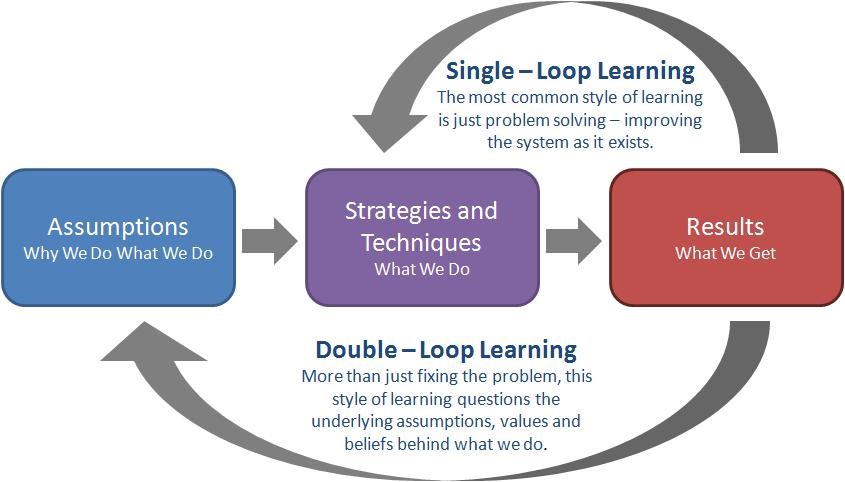Ever feel like you’re stuck in a loop trying to fix problems over and over again? You’re not alone! Many organizations rely on single loop learning – identifying issues, implementing solutions, rinse and repeat. But real change requires digging deeper.
That’s where double loop learning comes in. With double loop, you don’t just ask “Are we doing things right?” but also “Are we doing the right things?” Questioning underlying assumptions is the name of the game.
If you want to focus on accelerated learning then Double Loop Learning can be an effective method to ensure that you continue to progress in anything that you do.
Double loop learning might sound complex, but have no fear – this handy guide breaks it down step-by-step. We’ll explore where double loop came from, how it works, and most importantly, how to do it. Expect straightforward explanations, real-world examples, and pro tips for bringing more double loop into your organization.
Whether you’re an executive looking to spur innovation, a manager hoping to empower your team, or an employee eager to challenge the status quo, double loop learning is a game changer. So let’s get looping – double looping, that is! With the right mindset shift, anything is possible.

The Concept of Double Loop Learning
So where did double loop learning come from? Back in the 1970s, organizational theorist Chris Argyris introduced the concept. He realized organizations needed more than a quick-fix approach – they needed real transformational change.
That’s when double loop learning was born. Let’s break it down:
Single loop learning = finding errors, taking corrective action, and moving on. It’s like a thermostat turning on the heat when it gets too cold. The underlying setting stays the same.
Double loop learning = questioning core assumptions and values that led to the error. It’s like not just resetting the thermostat, but figuring out why the room gets cold and how to better insulate it.
With double loop learning, the underlying causes are addressed, not just the surface symptoms. Rather than just asking “Are we doing things right?” you also ask “Are we doing the right things?” It’s learning on a whole new level.
Here’s a simple diagram showing the difference:

Single loop fixes symptoms, double loop gets to the source. One is a bandage, the other is surgery. Bandages fall off, but surgery lasts. That’s the power of double loop!
Key Principles
So what are the core principles that make double loop learning so powerful?
Question assumptions – Don’t take existing strategies, processes, or beliefs for granted. Ask “Why do we do things this way?” Be willing to challenge the status quo.
Example: A company realizes its policy of using third-party vendors is costing more than hiring in-house, so they critically assess if they should change their hiring practices.
Identify root causes – Dig beneath the surface to understand what beliefs or values actually led to mistakes, rather than just addressing superficial symptoms.
Example: A declining customer satisfaction rating leads a company to survey customers and discover dissatisfaction with a recent product change, so they reconsider their design philosophy.
Consider radical change – Be open to fundamentally rethinking strategies and policies rather than just making incremental tweaks. Don’t limit yourself to “How can we improve this?”, ask “Should we be doing this at all?”
Example: A struggling product line doesn’t just get rebranded, the company re-evaluates its entire portfolio strategy.
Change mindsets – Double loop learning transforms underlying assumptions and mental models to encourage new perspectives and possibilities.
Example: A lack of innovation leads an executive team to recognize a culture of risk aversion, so they actively work to promote risk-taking.

Implementing Double Loop Learning
Implementing double loop learning starts with you. Here are some ways to adopt it as an individual:
- Reflect on your assumptions – Regularly take time to examine your core beliefs and mental models. Actively question why you think the way you do.
- Seek understanding – When facing disagreements, make an effort to truly understand other perspectives before reacting. Ask clarifying questions.
- Admit uncertainty – Be comfortable saying “I don’t know” and embracing the discovery process of rethinking assumptions. Change your mindset.
- Be self-critical – Don’t just defend your current beliefs. Look for ways your assumptions may be flawed or biased and be open to self-correction.
- Have courageous conversations – Respectfully discuss radical ideas and alternative viewpoints with others. Be willing to engage, not just dismiss.
- Take in feedback – Actively listen when others critique your reasoning and direction. Consider their perspective rather than becoming defensive.
Double loop learning requires humility, self-awareness, and willingness to grow. By modeling it as an individual, you can influence and inspire groups around you to adopt it. Progress starts from within.

Obstacles and Challenges of Double Loop Learning
Embracing double loop learning faces hurdles. Being aware of these challenges can help you overcome them:
- Fear of being wrong – Questioning your long-held beliefs can feel like an admission you’ve been wrong. But being open to growth is a strength.
- Resistance to change – It’s natural to default to existing routines and assumptions without reevaluating them. Make an effort to actively reflect.
- Narrow perspectives – You may not realize your beliefs are too limited. Seek broad input to expand your thinking.
- Biased reasoning – Be watchful that your own biases and tendencies toward confirmation aren’t undermining your opinions.
- Complacency – If things seem fine, it’s tempting not to question deeper issues. Discomfort can signal needed growth. Don’t ignore it.
- Lack of skills – Active listening, giving constructive feedback, and public reflection require practice to develop. Commit to honing them.
Double loop learning needs courage. But expanding your thinking leads to improvement. By being aware of these hurdles and deliberately working to overcome them, you can achieve remarkable personal growth.

Examples and Case Studies
Seeing double loop learning in action makes it concrete. Here are some illuminating examples:
Mindset shift – An engineer realized he was avoiding risky projects that could expand his skills. By embracing uncertainty as part of learning, he took on more innovative assignments.
Rethinking routines – A writer relied on the same routines for years. In questioning her assumptions about when she was most creative, she discovered writing at new times unlocked fresh ideas.
Owning bias – A manager noticed he was undervaluing input from female team members. Through consciously correcting this bias, he was able to improve diversity on his team.
Letting go of ego – A young professional took all critical feedback as a personal attack. He learned to let go of his ego and view feedback as an opportunity for improvement.
Broadening circles – An academic tended to collaborate with the same like-minded colleagues. By expanding her network, she gained new perspectives that enriched her research.
By studying real-world examples of individuals challenging their own assumptions in different contexts, you can get inspiration for applying double loop learning in your life. Don’t be afraid to cast a critical eye inward!

Benefits and Impact
Adopting double loop learning brings profound benefits at the individual level:
Greater innovation – Questioning your assumptions unlocks creativity. You come up with ideas that would have previously seemed unthinkable.
Improved decision making – Rooting out flawed mental models prevents poor judgment. You consider problems more multidimensionally.
Increased agility – By continually reflecting, you can rapidly change course when needed. You don’t cling rigidly to the status quo.
Stronger relationships – Openness to feedback improves your emotional intelligence and empathy. You have more rewarding connections.
Reduced bias – Examining your potential biases helps you become more objective, fair, and inclusive.
Enhanced confidence – By embracing uncertainty, your self-assurance comes from growth, not defensiveness. You become more decisive.
Purposeful life – Introspection on your core values and beliefs allows you to live more authentically. You realize your full potential.
Pursuing personal growth is deeply rewarding. By following the principles of double loop learning, you set yourself on a lifelong path of increasing wisdom, capabilities, and fulfillment.

Key Takeaways
Double loop learning is a powerful mindset shift. By questioning your assumptions and rethinking your beliefs, you open the door to tremendous personal growth.
Key Takeaways:
- Reflect critically on your core assumptions and mental models. Don’t take them as gospel.
- Be willing to radically reevaluate your beliefs, not just make incremental fixes.
- Admit uncertainty, embrace mistakes as learning, and actively welcome criticism.
- Change your habits and routines to shake up stagnant thinking.
- Broaden your network and seek out different perspectives to gain wisdom.
- Have courageous conversations where you constructively challenge your own and others’ assumptions.
Action Steps:
- Set aside 15 minutes each day for self-reflection on your beliefs.
- Find a mentor who can give you honest, constructive feedback on your thinking.
- Read books and articles that expose you to radically different worldviews.
- Take on bold projects or assignments that push you out of your comfort zone.
- Have probing discussions with people who disagree with you. Listen intently.
Adopting double loop learning requires effort but pays dividends. By implementing these actions, you will unlock transformational personal growth and empower yourself for a fulfilling life of ever-expanding possibilities.
